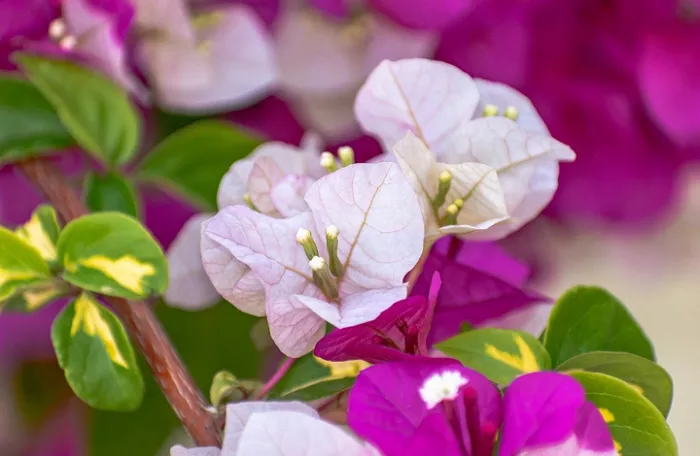Bougainvillea, with its vibrant and flamboyant blooms, is a favorite among gardeners for its ability to transform any space into a tropical paradise. However, getting this stunning plant to flower can sometimes be a challenge. Whether you’re a seasoned gardener or a novice, understanding the right conditions and care practices can make all the difference. In this article, we’ll explore the secrets to encouraging your bougainvillea to burst into a riot of color.
Understanding the Bougainvillea
Bougainvillea is a tropical plant native to South America, known for its stunning papery bracts that come in a variety of colors, including pink, purple, red, and white. These bracts are often mistaken for flowers, but the true flowers are actually the small, white, tubular blooms nestled within them. Bougainvillea thrives in warm climates and is well-suited to regions with long, hot summers and mild winters. However, with the right care, it can also flourish in more temperate zones.
The Ideal Environment
To encourage your bougainvillea to flower, it’s crucial to provide the right environment. This plant loves plenty of sunlight, ideally at least six hours per day. If you live in a region with intense afternoon sun, some partial shade during the hottest part of the day can help prevent leaf scorch. Bougainvillea also prefers well-draining soil, as it is susceptible to root rot if the soil remains waterlogged. A sandy or loamy soil mix with a slightly acidic to neutral pH (around 6.0-7.0) is ideal.
Watering and Fertilizing
Proper watering and fertilizing are key factors in promoting blooming. Bougainvillea is somewhat drought-tolerant, but it still needs consistent moisture, especially during the growing season. Allow the top inch of soil to dry out between waterings to prevent overwatering. During the blooming period, which is typically spring and summer, it’s essential to provide the right nutrients. Use a high-phosphorus fertilizer, such as a 10-20-10 or 15-30-15 formula, to encourage flower production. Apply the fertilizer every 4-6 weeks, following the package instructions for the correct dosage.
Pruning for Better Blooms
Pruning is another essential aspect of bougainvillea care. Regular pruning helps shape the plant and encourages new growth, which is where the flowers will appear. The best time to prune is in late winter or early spring, just before the plant begins its active growth period. Remove any dead or damaged branches, and trim back long, leggy growth to promote bushier, more compact plants. Be careful not to over-prune, as this can reduce the number of blooms. Aim to remove no more than one-third of the plant’s overall growth during each pruning session.
Encouraging Dormancy
In some cases, bougainvillea may need a period of dormancy to trigger blooming. This is especially true for plants grown in containers or in regions with mild winters. To induce dormancy, reduce watering and stop fertilizing in the fall. Allow the plant to rest for a few weeks, and then gradually resume watering and fertilizing in the spring. This change in conditions can signal the plant to produce new growth and flowers.
Common Issues and Solutions
Despite your best efforts, there may be times when your bougainvillea still doesn’t flower as expected. Several factors can contribute to this issue, including insufficient sunlight, over-fertilization with nitrogen, and improper watering. If your plant is not blooming, first check its light exposure and adjust if necessary. Too much nitrogen can promote leaf growth at the expense of flowers, so ensure you are using the right type of fertilizer. Finally, review your watering practices to ensure the plant is not being overwatered or underwatered.
Propagation and Planting
If you’re looking to expand your bougainvillea collection, propagation is a great option. The easiest method is through stem cuttings. Take a cutting from a healthy, mature plant, ensuring it is about 6-8 inches long and has several leaf nodes. Remove the lower leaves and dip the cut end in rooting hormone. Plant the cutting in a well-draining potting mix and keep it moist but not soggy. Within a few weeks, the cutting should develop roots and can be transplanted to a larger container or planted directly in the ground.
Choosing the Right Variety
When selecting a bougainvillea for your garden, consider the variety that best suits your climate and space. Some varieties are more compact and well-suited to containers, while others are vigorous climbers that can cover large walls or fences. Popular varieties include ‘Barbara Karst,’ known for its bright pink bracts, and ‘Raspberry Ice,’ which features variegated foliage and raspberry-colored blooms. Research the specific needs of the variety you choose to ensure it thrives in your garden.
Conclusion
Bougainvillea is a rewarding plant that can add a touch of exotic beauty to any garden. By providing the right environment, proper care, and timely pruning, you can encourage your bougainvillea to produce an abundance of stunning blooms. Remember to be patient, as some plants may take a year or two to settle in and reach their full flowering potential. With a little effort and attention, your bougainvillea will soon be the star of your garden, dazzling with its vibrant colors and lush foliage.


